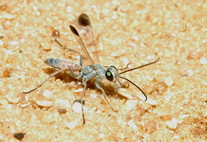Abstract
Samples collected from the Antarctic (ANDEEP/2002) and Mid-Pacific (BIONOD/2012) Oceans allowed analyses of several specimens of the family Neotanaidae. From these surveys two new species are described: Neotanais bicornutus and Venusticrus thor. The new material led to a re-diagnosis of Venusticrus, and N. rotermundiae is now assigned to this genus. The male of N. bicornutus shares a number of characters with the "robustus" species group, but differs by having a pleotelson about 1.5 times as wide as long, cheliped carpus about 1.5 times as long as cephalothorax, cheliped propodus with two long dorsal projections, and uropod endopod article 1 with 8–10 fine setae proximal to mid-length on outer margin. The N. bicornutus preparatory female differs from all species by a combination of characters including the number of setae on dorsal margin of cheliped carpus (about 15 setae), the uropod attachment slightly posterior to mid-length, uropod basal article about 2.7 times as long as endopod article 1. The female of V. thor differs from those of V. insolitus, V. glandurus and V. rotermundiae by the body proportions, the pleon having three lateral setae on epimera, pleon with a blunt ventral keel, pereopodal setation, number of setae on maxilliped endite and basis as well as other characters. Total genomic DNA was extracted from two specimens of V. thor and sequences of two genes, i.e., cytochrome oxidase 1 (COI) and ribosomal (28S) were obtained.

